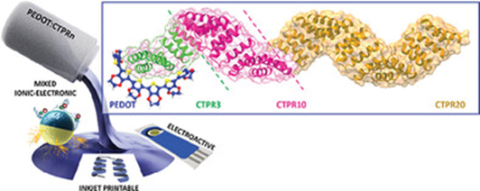Poly (3,4-ethylenedioxythiophene) (PEDOT) doped with polystyrene sulfonate (PSS) is the most used conducting polymer from energy to biomedical applications. Despite its exceptional properties, there is a need for developing new materials that can improve some of its inherent limitations, e.g., biocompatibility. In this context, doping PEDOT is propose with a robust recombinant protein with tunable properties, the consensus tetratricopeptide repeated protein (CTPR). The doping consists of an oxidative polymerization, where the PEDOT chains are stabilized by the negative charges of the CTPR protein. CTPR proteins are evaluated with three different lengths (3, 10, and 20 identical CTPR units) and optimized varied synthetic conditions. These findings revealed higher doping rate and oxidized state of the PEDOT chains when doped with the smallest scaffold (CTPR3). These PEDOT:CTPR hybrids possess ionic and electronic conductivity. Notably, PEDOT:CTPR3 displayed an electronic conductivity of 0.016 S cm−1, higher than any other reported protein-doped PEDOT. This result places PEDOT:CTPR3 at the level of PEDOT-biopolymer hybrids, and brings it closer in performance to PEDOT:PSS gold standard. Furthermore, PEDOT:CTPR3 dispersion is successfully optimized for inkjet printing, preserving its electroactivity properties after printing. This approach opens the door to the use of these novel hybrids for bioelectronics.

09/02/2024
Engineering Proteins for PEDOT Dispersions: A New Horizon for Highly Mixed Ionic-Electronic Biocompatible Conducting Materials
Title: Engineering Proteins for PEDOT Dispersions: A New Horizon for Highly Mixed Ionic-Electronic Biocompatible Conducting Materials
Journal: Small, 2023. DOI: 10.1002/smll.202307536
